|
The Home of the Banjo
Clock
by Bob
Brooke
Nestled in the rolling hills of Central Massachusetts, Willard House is
one of Grafton's oldest buildings, constructed by Joseph Willard in the
early 18th century in what was then known as the Indian settlement of
Hassanamisco. Four of Joseph's grandsons - Benjamin, Simon, Ephraim and
Aaron Willard---would become America's preeminent 19th-century
clockmakers, making their first clocks in 1766 in their small Grafton
workshop. In 1802, Simon Willard obtained a patent for his Improved
Timepiece, or "banjo" clock. Today, clock historians consider the banjo
clock to be one of the most significant styles of early 19th century
American timepieces.
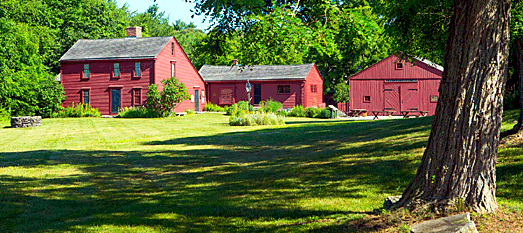
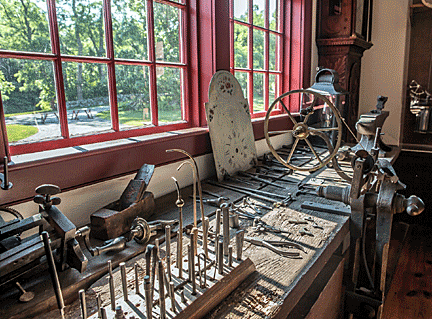 Founded
by Dr. Roger and Imogene Robinson in 1969, and opened to the public in
1971, the museum features world's largest collection of Willard clocks.
The collection is displayed in period room settings in the 1718 Joseph
Willard homestead, the 1766 Benjamin Willard Clock Manufactory and three
modern galleries, and includes over 90 Willard clocks. Founded
by Dr. Roger and Imogene Robinson in 1969, and opened to the public in
1971, the museum features world's largest collection of Willard clocks.
The collection is displayed in period room settings in the 1718 Joseph
Willard homestead, the 1766 Benjamin Willard Clock Manufactory and three
modern galleries, and includes over 90 Willard clocks.
The museum
collection also includes Willard family portraits and furnishings,
Colonial, Federal and Empire period furniture, antique Oriental rugs,
19th-century women's costumes,18th-century American and English pewter,
Victorian dolls and doll furniture, military and hunting weapons, Nipmuc
Indian artifacts, and original documents signed by Thomas Jefferson and
James Madison.
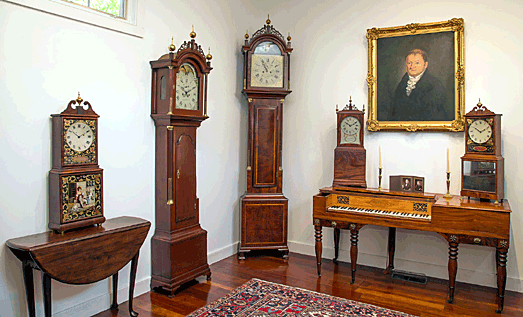
The couple spent over 40 years of their lives dedicated to the
preservation of this historic home and to telling the important story of
the Willard family clock makers.
Who was Simon Willard?
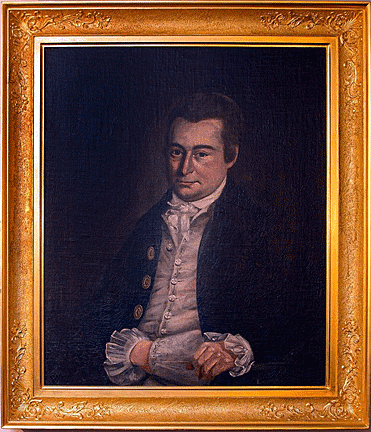 Simon
Willard was the creator of the timepiece that came to be known as the
banjo clock. He was the most celebrated of a family of Massachusetts
clock makers who designed and produced brass-movement clocks between
1765 and 1850. Simon
Willard was the creator of the timepiece that came to be known as the
banjo clock. He was the most celebrated of a family of Massachusetts
clock makers who designed and produced brass-movement clocks between
1765 and 1850.
About 1780 Willard moved from Grafton, where he had been apprenticed to
a clock maker, and settled in Roxbury, near Boston, where he continued
studies with his brother Benjamin. Simon Willard worked in Roxbury until
his retirement in 1839. He catered to a wealthy clientele, including
Thomas Jefferson, who commissioned a clock for the University of
Virginia. Willard made various types of clocks but specialized in pieces
for churches, halls, and galleries, though he focused on producing
accurate, simple movements.
The Banjo Clock
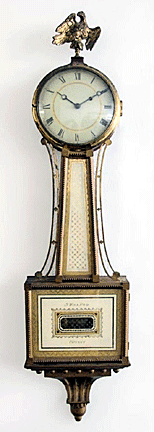 During
his early career in Grafton, Simon worked to produce a compact and
affordable wall clock. The results of this effort were the rare Grafton
Wall Clocks often referred to as Willard experimentals. On February 8,
1802, Willard patented an eight-day pendulum clock housed in a case
having a round top portion bearing the dial, an elongated central
portion, and a rectangular base. Though the shape of the upper part of
the case inspired the term banjo clock, he called it called it his
“Improved Patent Timepiece.” During
his early career in Grafton, Simon worked to produce a compact and
affordable wall clock. The results of this effort were the rare Grafton
Wall Clocks often referred to as Willard experimentals. On February 8,
1802, Willard patented an eight-day pendulum clock housed in a case
having a round top portion bearing the dial, an elongated central
portion, and a rectangular base. Though the shape of the upper part of
the case inspired the term banjo clock, he called it called it his
“Improved Patent Timepiece.”
It was the first American eight-day wall clock, the first American wall
clock to have the pendulum suspended in front of the weight in the case,
and the first American wall clock to have the weight attached to a
pulley. He made the brass clock mechanism smaller, therefore saving
brass which was in scarce supply in the early 19th century. Its shape
was an imitation of the traditional wheel barometers. Simon built his
first Patent Timepieces by hand, to order. By 1805 the clockworks, and
standard cases, could be produced in quantity, reducing the cost of the
clock.
Its small size meant a much lower price of 30 dollars, although this was
still a large amount of money for the average family. Nonetheless,
Simon's Patent Timepiece revolutionized the clock industry, becoming the
most popular clock in the United States.
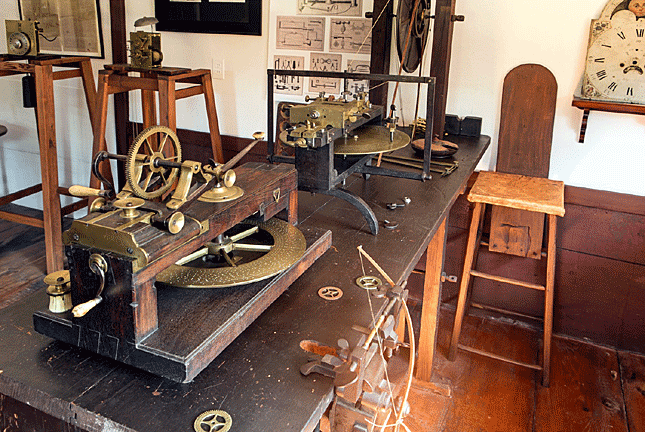
Though Simon patented his Timepiece later in 1802, most of his
competitors dodged it, reaping much money with their own versions of the
banjo clock. However, Simon never filed a case against such usage. After
1802, in Simon's workshop, the smaller banjo and shelf clocks were the
bread and butter models while Simon pursued his other great projects.
Eventually, Willard's workshop manufactured 4,000 banjo and shelf
clocks.
How did the collection get started?
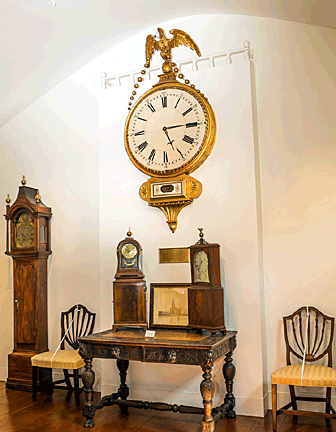 Dr.
Robinson began collecting Willard clocks in 1955, with a brass-dial
Simon Willard eight-day clock. His clocks formed the basis for the
museum's collection, now known as the Roger Robinson Clock Collection.
Imogene's vision for the museum was shown through the lovingly curated
displays of period furniture, needlework, and Willard family treasures. Dr.
Robinson began collecting Willard clocks in 1955, with a brass-dial
Simon Willard eight-day clock. His clocks formed the basis for the
museum's collection, now known as the Roger Robinson Clock Collection.
Imogene's vision for the museum was shown through the lovingly curated
displays of period furniture, needlework, and Willard family treasures.
Located among the rolling farmlands adjacent to the Tuft University
Cummings School of Veterinary Medicine just off Route 30 in North
Grafton, Massachusetts.
The Willard House offers guided tours, which last approximately an hour
(or more, depending how many questions you have). Tours depart when
there are enough participants. The last tour of the day begins at
3:00pm.
<
Back to More Antiques to View
Next Article
> |
